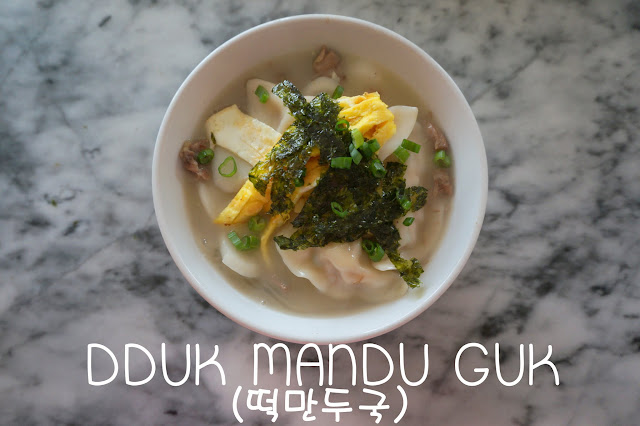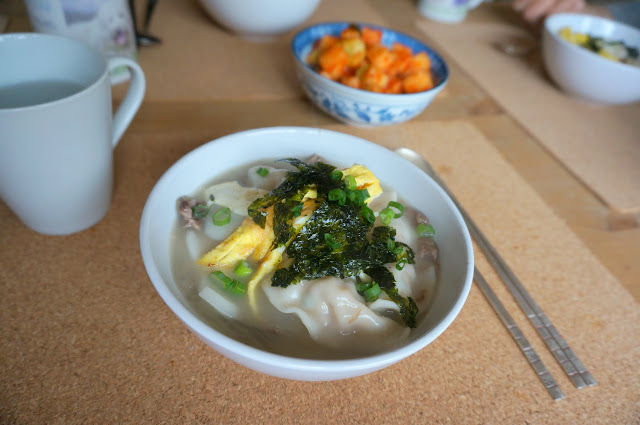Korean Rice Cake & Dumpling Soup | Dduk Mandu Guk (떡만두국)
Every year of my life, I've woken up on New Year's Day and eaten a big bowl of dduk guk. The past few years, my sister and I have been making kimchi mandu a few days before the holiday so that we could enjoy a heartier bowl of soup.
I've been a bit lazy about documenting the process of making dduk guk. In fact, my previous dduk guk post is just a singular photo and some vague instructions. So, when 2016 rolled around, I took the time to make a decent photo diary.
Ingredients [serves 4]:
broth
1 lb. beef shanks
8 to 10 cups water
6 cloves garlic, smashed
soup
3 cloves garlic, minced
1 teaspoon sesame oil
salt to taste
handful glass noodles
4 cups sliced rice cake
12 mandu
2 eggs, separated
1 scallion, chopped
1 sheet laver, cut into strips
The stock is super easy. Basically, soak the shanks in cold water for about an hour to drain the myoglobin. This will help yields a clearer, cleaner stock. Then, add to a pot with plenty of water and some garlic. Bring to a boil and skim off any foam and scum. Then, reduce the heat to a simmer and let the stock cook for about 2 hours or until the beef is tender. That's the stock; done. If you're squeamish about fat, you can chill the stock in the fridge and then pick off the solidified fat.
When you're ready to make your dduk mandu guk, shred the beef into the cooled stock (and discard the bones).
Pop the stock pot onto the hob and heat up.
While you're waiting for the soup to get hot, you can work on the garnishes. Separate two eggs and cook the whites and yolks separately and then cut into strips. Cut the laver into strips using scissors. And chop up some scallions.
Once the stock is hot, add in the garlic, sesame oil, and salt to taste. I probably add in about 2 teaspoons. Then, once the stock is boiling, add in the glass noodles. Once the noodles are cooked mostly through, add in the rice cakes and dumplings. Cook until the rice cakes are tender and the dumplings are floating.
I store my rice cakes in the freezer. To defrost quickly, I soak them in water until they're no longer frozen. To defrost a bit more slowly (and if I remember), I leave them in the fridge overnight.
I also store my dumplings in the freezer. On this particular day, I made the dumplings that actual morning so I had a fresh batch. However, if I were to use frozen dumplings, I would let them defrost for about an hour at room temperature until they're no longer rock-frozen-hard. The trick is to let them defrost in a single layer, as the skins can become gummy and you'll end up with some siamese dumplings, if you're not careful.
Use tongs to grab some noodles when you're serving. And then, use a ladle to grab the rice cakes, dumplings, and broth.
Add all of the garnishes and serve immediately while the soup is still piping hot.
We had our soup with kkakdugi, which is definitely the perfect kimchi accompaniment to this dish.
This soup is super comforting and perfect in the wintertime. The rice cakes are soft, the broth has deep flavor, the dumplings are awesome, and I like getting a little garnish in every bite. It's definitely a favorite in our house; I mean, I wouldn't make it otherwise.
Here's the recipe page:
I've been a bit lazy about documenting the process of making dduk guk. In fact, my previous dduk guk post is just a singular photo and some vague instructions. So, when 2016 rolled around, I took the time to make a decent photo diary.
Ingredients [serves 4]:
broth
1 lb. beef shanks
8 to 10 cups water
6 cloves garlic, smashed
soup
3 cloves garlic, minced
1 teaspoon sesame oil
salt to taste
handful glass noodles
4 cups sliced rice cake
12 mandu
2 eggs, separated
1 scallion, chopped
1 sheet laver, cut into strips
The stock is super easy. Basically, soak the shanks in cold water for about an hour to drain the myoglobin. This will help yields a clearer, cleaner stock. Then, add to a pot with plenty of water and some garlic. Bring to a boil and skim off any foam and scum. Then, reduce the heat to a simmer and let the stock cook for about 2 hours or until the beef is tender. That's the stock; done. If you're squeamish about fat, you can chill the stock in the fridge and then pick off the solidified fat.
When you're ready to make your dduk mandu guk, shred the beef into the cooled stock (and discard the bones).
Pop the stock pot onto the hob and heat up.
While you're waiting for the soup to get hot, you can work on the garnishes. Separate two eggs and cook the whites and yolks separately and then cut into strips. Cut the laver into strips using scissors. And chop up some scallions.
Once the stock is hot, add in the garlic, sesame oil, and salt to taste. I probably add in about 2 teaspoons. Then, once the stock is boiling, add in the glass noodles. Once the noodles are cooked mostly through, add in the rice cakes and dumplings. Cook until the rice cakes are tender and the dumplings are floating.
I store my rice cakes in the freezer. To defrost quickly, I soak them in water until they're no longer frozen. To defrost a bit more slowly (and if I remember), I leave them in the fridge overnight.
I also store my dumplings in the freezer. On this particular day, I made the dumplings that actual morning so I had a fresh batch. However, if I were to use frozen dumplings, I would let them defrost for about an hour at room temperature until they're no longer rock-frozen-hard. The trick is to let them defrost in a single layer, as the skins can become gummy and you'll end up with some siamese dumplings, if you're not careful.
Use tongs to grab some noodles when you're serving. And then, use a ladle to grab the rice cakes, dumplings, and broth.
Add all of the garnishes and serve immediately while the soup is still piping hot.
We had our soup with kkakdugi, which is definitely the perfect kimchi accompaniment to this dish.
This soup is super comforting and perfect in the wintertime. The rice cakes are soft, the broth has deep flavor, the dumplings are awesome, and I like getting a little garnish in every bite. It's definitely a favorite in our house; I mean, I wouldn't make it otherwise.
Here's the recipe page:






















Comments
Post a Comment
I'd love to hear what you have to say!